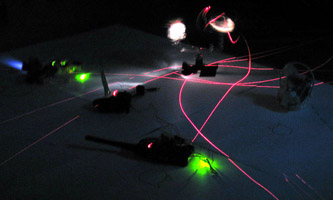Low Tech Sensors and Actuators investigates how low-tech sensors and interactive actuators can be produced inexpensively from hacked toys and devices.
Artists and architects who want to experiment with concepts of interactive spaces and responsive systems are often prevented from doing so because of the complexity, logistics or costs of such systems. Prototype research seems too expensive and the most interesting concepts remain on the drafting board until a suitable client/investor/sponsor is found.

A solution is at the heart of open source architecture: the combination of reusability and “low-tech”.
New media artists and architects don’t necessarily need the precision and accuracy that scientists usually do to explore interaction. They work well with the “making-the-best-of-what-we-have” approach, using artifacts at hand, and are comfortable with the idea of “hacking” existing technology. It is possible to design interfaces, sensors, bio-feedback devices and actuators using relatively simple technology that might even already exist in people’s homes: remote control toys are these days ripe for dismantling and reworking; kids walkie-talkies can be used to set up a simple wireless network; energy source for a simple interactive device could be generated from the movements and footsteps of people within a space.
The Low Tech Sensors and Actuators project develop low-tech sensors and interactive actuators that can be produced inexpensively from off-the-shelf toys and devices. These “hacked” devices can form part of a “kit-of-parts” that new media artists and interactive architects could use for their projects.
PDF of the proposal.
By Usman Haque and Adam Somlai-Fischer at Aether Architecture.
